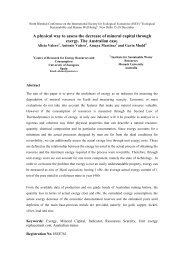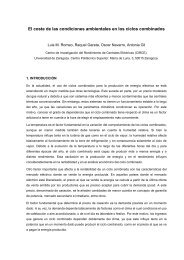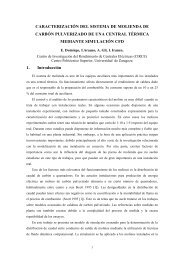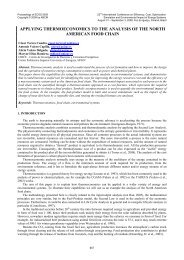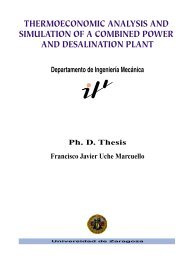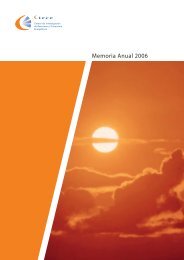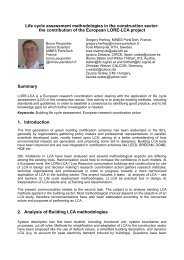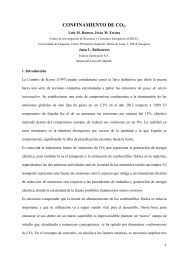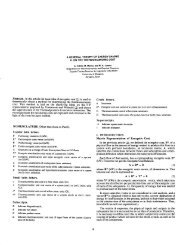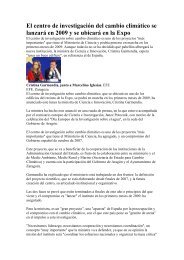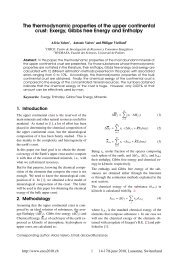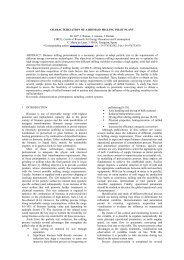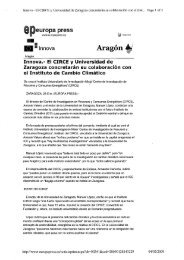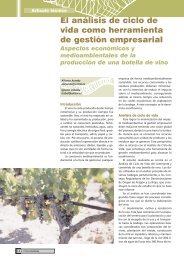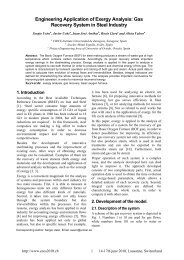Exergy evolution of the mineral capital on earth - circe
Exergy evolution of the mineral capital on earth - circe
Exergy evolution of the mineral capital on earth - circe
You also want an ePaper? Increase the reach of your titles
YUMPU automatically turns print PDFs into web optimized ePapers that Google loves.
4 STARTING POINT, OBJECTIVES AND SCOPE<br />
informati<strong>on</strong> source. As Faber [91] claimed, <str<strong>on</strong>g>the</str<strong>on</strong>g> true intertemporal scarcity <str<strong>on</strong>g>of</str<strong>on</strong>g> envir<strong>on</strong>mental<br />
goods must be analyzed and appropriate indicators for <str<strong>on</strong>g>the</str<strong>on</strong>g> scarcity <str<strong>on</strong>g>of</str<strong>on</strong>g><br />
<str<strong>on</strong>g>the</str<strong>on</strong>g>se goods must be found.<br />
In this PhD, we have dived in data bases <str<strong>on</strong>g>of</str<strong>on</strong>g> many different instituti<strong>on</strong>s, organizati<strong>on</strong>s,<br />
universities and journals, searching for global numbers <str<strong>on</strong>g>of</str<strong>on</strong>g> <str<strong>on</strong>g>the</str<strong>on</strong>g> <str<strong>on</strong>g>mineral</str<strong>on</strong>g> <str<strong>on</strong>g>capital</str<strong>on</strong>g> <strong>on</strong><br />
<strong>earth</strong>. For some<strong>on</strong>e that never faced that task, it is surprising <str<strong>on</strong>g>the</str<strong>on</strong>g> lack <str<strong>on</strong>g>of</str<strong>on</strong>g> existing<br />
informati<strong>on</strong> about our resources not <strong>on</strong>ly in <str<strong>on</strong>g>the</str<strong>on</strong>g> past, but also in <str<strong>on</strong>g>the</str<strong>on</strong>g> present. This is<br />
a clear indicator <str<strong>on</strong>g>of</str<strong>on</strong>g> <str<strong>on</strong>g>the</str<strong>on</strong>g> little importance that humankind has placed in investigating<br />
<str<strong>on</strong>g>the</str<strong>on</strong>g> resources that nature gives us for free.<br />
Generally, <str<strong>on</strong>g>the</str<strong>on</strong>g> instituti<strong>on</strong>s owning informati<strong>on</strong> about resources do not interpret <str<strong>on</strong>g>the</str<strong>on</strong>g><br />
compiled values. And ir<strong>on</strong>ically, many studies claiming <str<strong>on</strong>g>the</str<strong>on</strong>g> end <str<strong>on</strong>g>of</str<strong>on</strong>g> natural resources<br />
are rarely based <strong>on</strong> <str<strong>on</strong>g>the</str<strong>on</strong>g> physical statistics provided by <str<strong>on</strong>g>the</str<strong>on</strong>g> formers.<br />
More resources data bases, better global statistics, <str<strong>on</strong>g>the</str<strong>on</strong>g> opening <str<strong>on</strong>g>of</str<strong>on</strong>g> global informati<strong>on</strong><br />
channels and impartial and serious interpretati<strong>on</strong>s <str<strong>on</strong>g>of</str<strong>on</strong>g> <str<strong>on</strong>g>the</str<strong>on</strong>g> informati<strong>on</strong> are key factors<br />
for transformati<strong>on</strong> to sustainability. And <str<strong>on</strong>g>the</str<strong>on</strong>g> data interpretati<strong>on</strong> must be undertaken<br />
with <str<strong>on</strong>g>the</str<strong>on</strong>g> help <str<strong>on</strong>g>of</str<strong>on</strong>g> appropriate indicators.<br />
This PhD has tried to fill with physical c<strong>on</strong>tent some <str<strong>on</strong>g>of</str<strong>on</strong>g> <str<strong>on</strong>g>the</str<strong>on</strong>g> sociological messages<br />
about resource scarcity published elsewhere. This has been accomplished by making<br />
a rigorous analysis <str<strong>on</strong>g>of</str<strong>on</strong>g> <str<strong>on</strong>g>the</str<strong>on</strong>g> global <str<strong>on</strong>g>mineral</str<strong>on</strong>g>s <strong>on</strong> <strong>earth</strong> through an indicator based <strong>on</strong><br />
<str<strong>on</strong>g>the</str<strong>on</strong>g> sec<strong>on</strong>d law <str<strong>on</strong>g>of</str<strong>on</strong>g> <str<strong>on</strong>g>the</str<strong>on</strong>g>rmodynamics. The next secti<strong>on</strong> provides an overview <str<strong>on</strong>g>of</str<strong>on</strong>g> <str<strong>on</strong>g>the</str<strong>on</strong>g><br />
different available scarcity indicators with its capabilities and drawbacks, so as to<br />
compare <str<strong>on</strong>g>the</str<strong>on</strong>g>m to <str<strong>on</strong>g>the</str<strong>on</strong>g> indicator chosen in this PhD.<br />
1.3 Scarcity indicators<br />
C<strong>on</strong>siderati<strong>on</strong> <str<strong>on</strong>g>of</str<strong>on</strong>g> scarcity and its measurement requires clarificati<strong>on</strong> <str<strong>on</strong>g>of</str<strong>on</strong>g> what we mean<br />
by scarcity. As Zwartendyk et al. [414] argue, physical scarcity refers to <str<strong>on</strong>g>the</str<strong>on</strong>g> relative<br />
rarity <str<strong>on</strong>g>of</str<strong>on</strong>g> an element or <str<strong>on</strong>g>mineral</str<strong>on</strong>g> substance in nature; it has nothing to do with<br />
human effort. Ec<strong>on</strong>omic scarcity has very much to do with <str<strong>on</strong>g>the</str<strong>on</strong>g> interests and needs<br />
<str<strong>on</strong>g>of</str<strong>on</strong>g> humans. It reflects that work is required to obtain <str<strong>on</strong>g>mineral</str<strong>on</strong>g> products and that we<br />
are willing to pay a price for <str<strong>on</strong>g>the</str<strong>on</strong>g>m. Generally, <str<strong>on</strong>g>the</str<strong>on</strong>g> greater <str<strong>on</strong>g>the</str<strong>on</strong>g> physical scarcity <str<strong>on</strong>g>of</str<strong>on</strong>g> a<br />
<str<strong>on</strong>g>mineral</str<strong>on</strong>g>, <str<strong>on</strong>g>the</str<strong>on</strong>g> costlier it will be to obtain, so its ec<strong>on</strong>omic scarcity may be greater as<br />
well.<br />
The scientific community has already started to study this issue and some physical<br />
and ec<strong>on</strong>omic indicators have been proposed.<br />
In <str<strong>on</strong>g>the</str<strong>on</strong>g> renowned work Scarcity and Growth 2 (1963) <str<strong>on</strong>g>of</str<strong>on</strong>g> Barnet and Morse [20], extracti<strong>on</strong><br />
costs were used as scarcity indicators. Extracti<strong>on</strong> cost is computed as <str<strong>on</strong>g>the</str<strong>on</strong>g><br />
amount <str<strong>on</strong>g>of</str<strong>on</strong>g> labor and <str<strong>on</strong>g>capital</str<strong>on</strong>g> required to produce a unit <str<strong>on</strong>g>of</str<strong>on</strong>g> output. The same indicator<br />
2 Scarcity and Growth was <str<strong>on</strong>g>the</str<strong>on</strong>g> first systematic empirical examinati<strong>on</strong> <str<strong>on</strong>g>of</str<strong>on</strong>g> historical trends.



